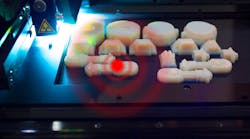Laser powder bed fusion (LBPF), a 3D printing technique commonly used to make metal parts, creates large thermal gradients between areas hit by the laser and areas not being struck. This creates pools of melted powder that are too shallow and leads to “keyholing,” the creation of deep cavities or pores in the underlying substrates. These pores reduce the finished part’s mechanical strength.
To reduce or eliminate these problems, researchers at the Lawrence Livermore National Laboratory have been experimenting with differently shaped laser beams used to fuse powder metals particles.
Current LBPF machines tend to use Gaussian laser beams with the laser’s intensity concentrated in the core of the beam. “But using Gaussian beams is a lot like using a flamethrower to cook your food. You don’t have a lot of control over how heat is deposited around the material,” says Livermore scientist Thej Umanath.
One type of shaped beam the team tested were Bessel beams, which create beams with a bullseye pattern. This more widely distributes the laser’s power and reduces the likelihood of pore formation and “keyholing.”
“With a Bessel beam, we redistribute some of the laser’s energy away from the center,” says Umanath. “This means we can engineer thermal profiles and reduce thermal gradients to aid microstructural grain refinement and, ultimately, result in denser parts and smoother surfaces.”
Besides overheating some sections of parts being built, another issue with conventional Gaussian beams is that they spread apart (diffract) as they travel, which prevents engineers from being able to focus Gaussian beams as well as Bessel beams. Consequently, it’s critical to precisely place workpieces before the build process begins, which isn’t as much of an issue with Bessel beams. So, using Bessel beams would mean technicians no longer have to rely on expensive and sensitive techniques for positioning workpieces during the entire build process.
The LLNL team shaped the beams by running the laser through two conical lenses to produce a donut shape, before passing it through additional optics and a scanner to create “rings” around the central beam.
Using high-speed imaging, the research team studied the dynamics of the melt pool, observing a substantial reduction in melt pool turbulence and mitigation of “spatter”—the molten particles of metal that fly from the laser’s path during a build—which generally leads to pore formation.
In mechanical studies and simulations, the team found that parts built with Bessel beams were denser, stronger and had more robust tensile properties than structures built with conventional Gaussian beams.
“Industry has long sought the ability to increase control of the LPBF process to minimize defects,” said Ibo Matthews, a researcher on the team. “Introducing complex structure to the laser beam adds increased flexibility to precisely control the laser-material interaction, heat deposition and, ultimately, the quality of the prints.”
Beam shaping is a less-expensive option than alternative scanning strategies because it can be done at little cost by incorporating simple optical elements to reduce the costs involved in post-processing techniques typically needed for parts built with Gaussian beams, according to the team.
LLNL researchers are currently experimenting with other beam shapes as part of an ongoing partnership with GE Global Research and are planning to investigate complex laser beam and polarization-shaping approaches for even better control over the quality of printed parts.


